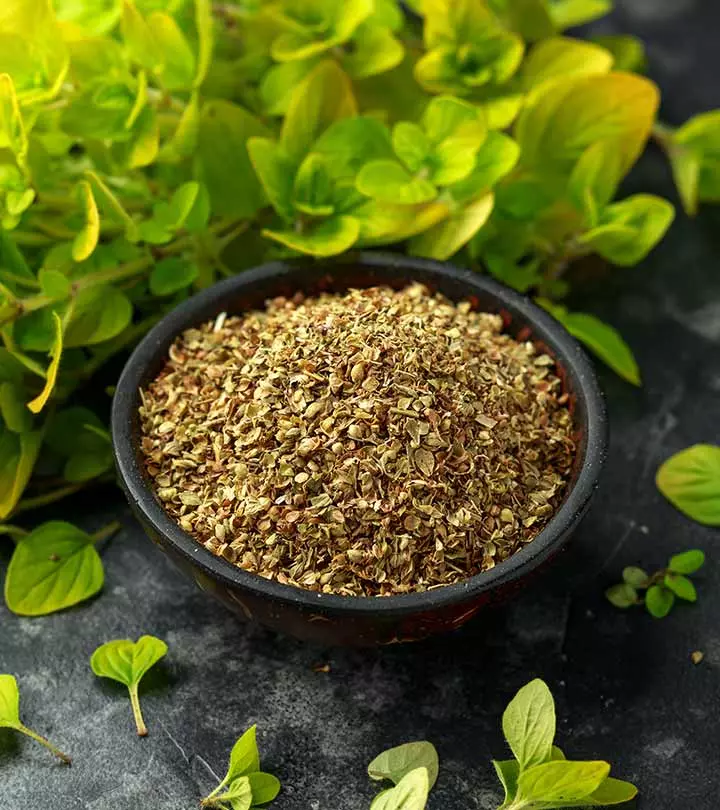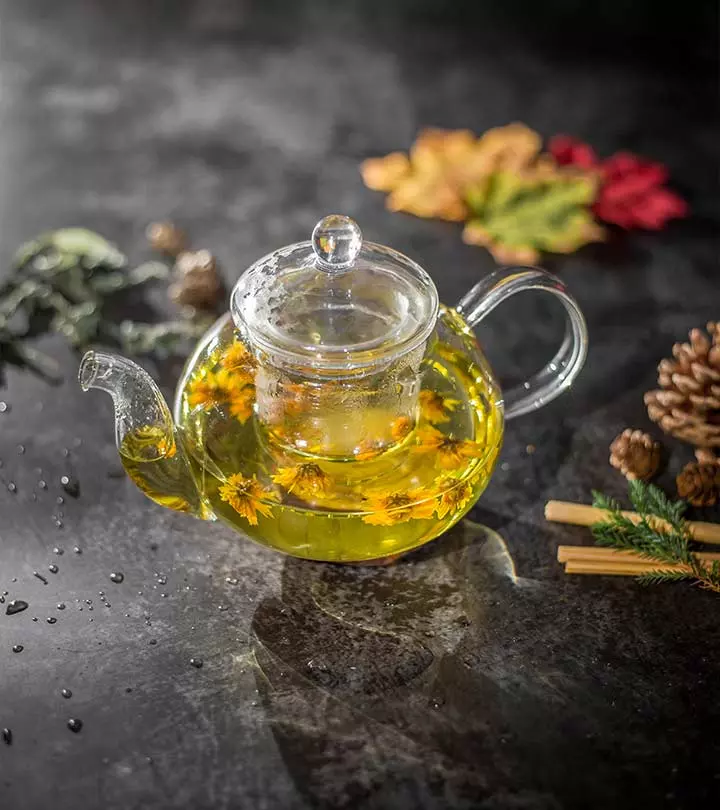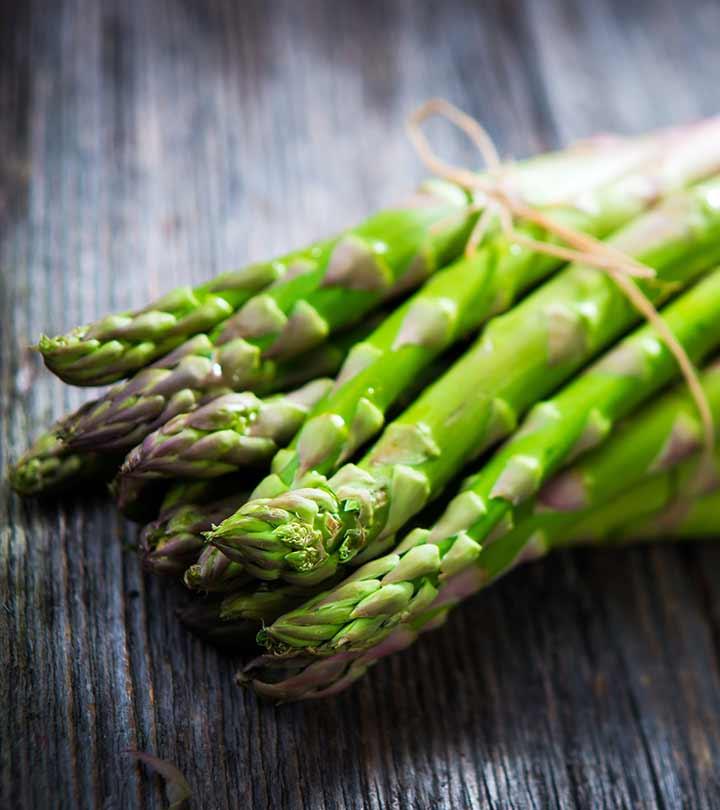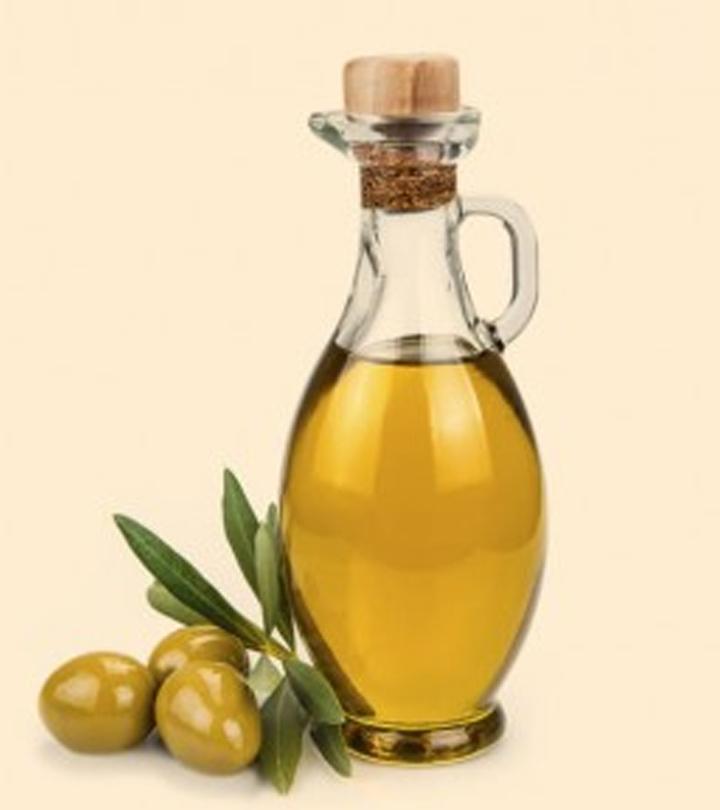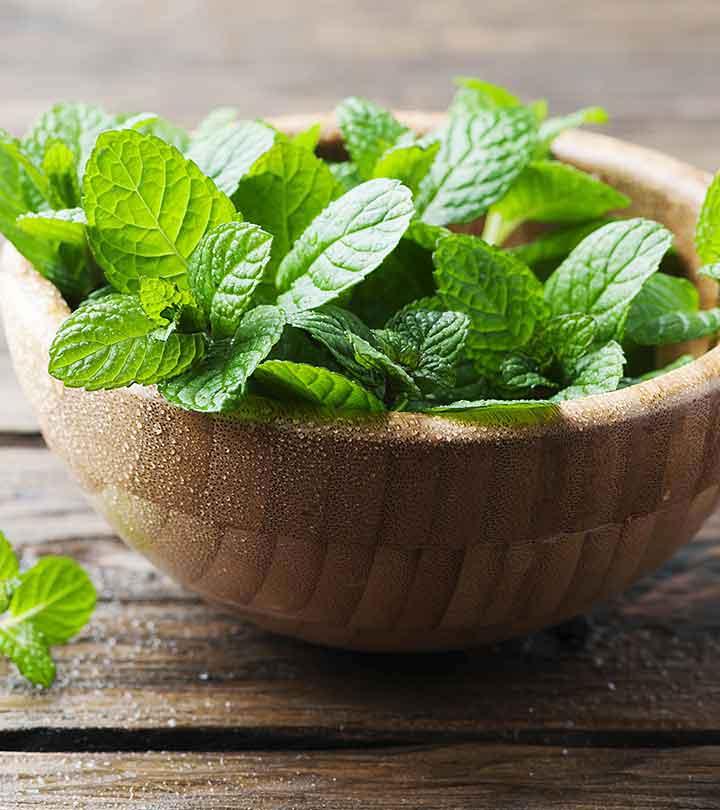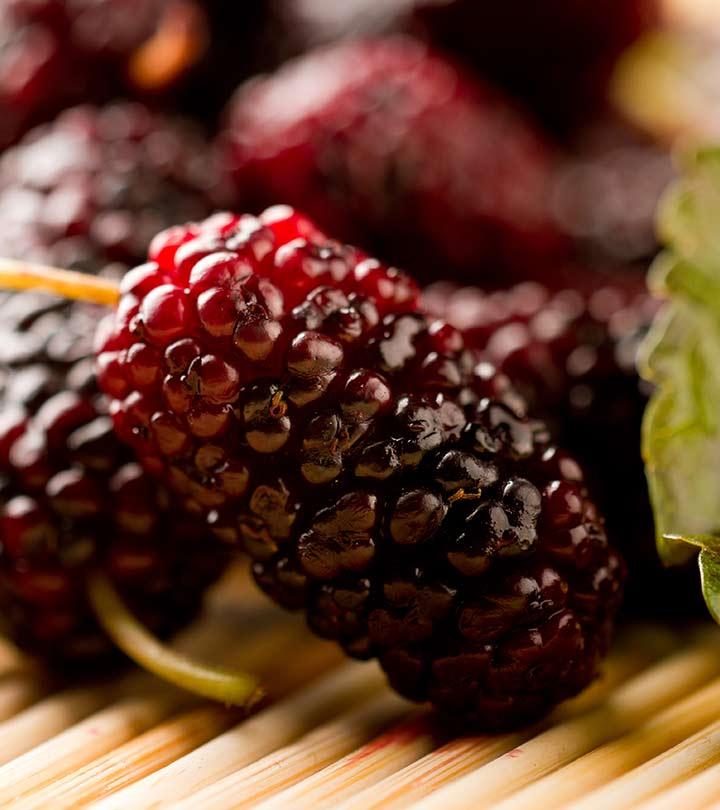9 Health Benefits Of Sage Leaves, Types, Side Effects, & Dose
A humble herb that can affect your mental and physical health in numerous positive ways.
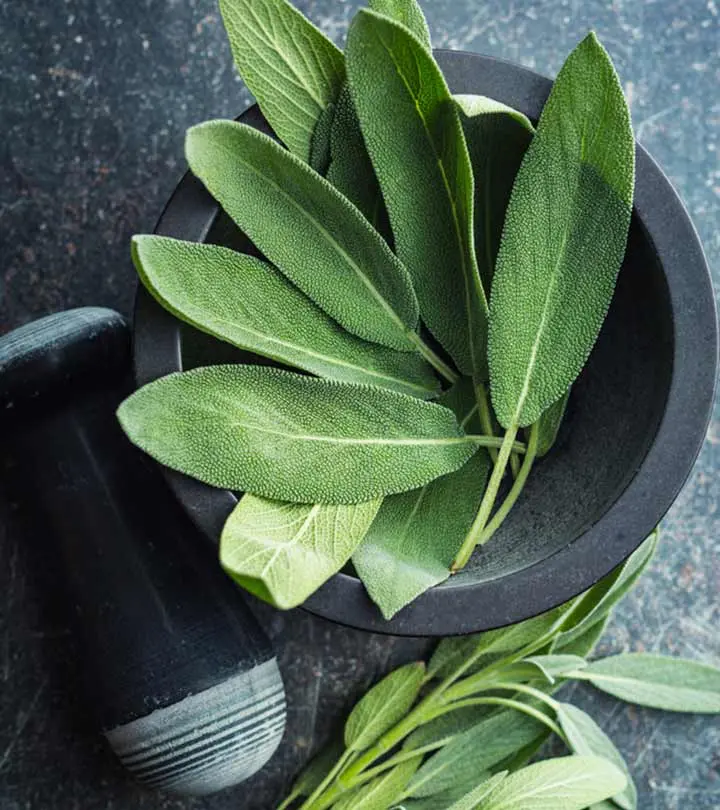
Image: Shutterstock
Sage is a flavoring agent that you use in cooking your favorite food items and a special herb with high medicinal values.
It has a strong aroma and adds extra flavor to sausages, salads, soups, or stews (1).
The benefits of sage herb can be attributed to its rich nutrient profile that plays a vital role in human health. The leaves of this spicy herb have been used to treat inflammation, hot flashes, soothe throat and mouth inflammation, and insomnia.
This article discusses the health benefits, active components, and possible side effects of sage. Take a look.
 Know Your Ingredient: Sage Leaf
Know Your Ingredient: Sage LeafWhat Is It?
Leaf from the shrub plant native to the Mediterranean region that is used in various cuisines.
What Are Its Benefits?
It may positively impact cognitive functioning, provide sun protection, promote hair health, control cholesterol levels, and regulate blood glucose levels.
Who Can Consume It?
Any one can safely consume it as a culinary herb or dietary supplement
How Often?
Can be consumed daily in moderation
Caution
Extended or excessive consumption can cause vomiting, vertigo, allergies, or seizures.
In This Article
What Are Sage Leaves?
Sage (Salvia officinalis) is a member of the ‘mint’ family (Lamiaceae). The plants have a unique aroma and pretty flowers in different colors. Many species of sage, including Salvia officinalis (common sage or kitchen/garden sage), are native to the Mediterranean region (1).
Sage was also used in ancient Egyptian, Roman, and Greek medicine. In fact, in Native American rituals, dried sage leaves are burned to promote healing, wisdom, protection, and longevity (1).
The leaves are an excellent reserve of essential oils and phenolic compounds. These are thought to be responsible for the herb’s medicinal value (1).
Based on their composition and origin, you have different types of sage, such as common sage, pineapple sage, and red sage. This wide variety makes sage one of the largest genera under the mint family.
What Are The Benefits Of Sage?
Sage has antiseptic, antimicrobial, and antioxidant properties. It boosts memory and controls blood sugar and cholesterol levels if used in optimal amounts.
1. May Boost Memory And Cognition
Several varieties of sage have been used to restore memory loss and cognitive decline, as mainly seen in Alzheimer’s disease. Similarly, it may also help with Parkinson’s disease. This decline in mental ability arises when neurotransmittersi Chemical messengers that carry chemical signals from neurons to the cells, supporting essential body functions. are degraded by your body’s specialized enzymes (1).
Acetylcholine, a neurotransmitter, is degraded by the enzyme acetylcholinesterase (AChE) in most brain disorders. Drugs and herbs that inhibit the activity of AChE are given to such subjects (1), (2).
The essential oils of sage have shown 46% AChE inhibition in lab trials. Its herbal extracts can protect the brain cells (neurons) from the effects of cholesterol accumulation and inflammation (amyloid ß- plaques) (1), (2).
2. May Combat Skin Aging
Studies suggested that sage and its compounds may help in combating skin aging. Sage could also improve wrinkles through a photoimaging mechanism (3).
Sclareol, a compound from sage, is widely used as a fragrance material. Studies show that this compound inhibits the UVB-induced damage to the skin. It could also recover the epidermal thickness that was reduced by UVB rays. Creams with sclareol could improve wrinkles by enhancing cellular proliferation (3).
 Trivia
Trivia3. May Promote Hair Growth
Sage is rich in antioxidants that can help to prevent and reduce the formation of new gray hair. The natural oils in sage strengthen the roots and accelerate healthy hair growth.
However, there is no evidence that shows a direct impact of sage on hair growth.
4. May Lower Cholesterol Levels
High LDL (bad) cholesterol and low HDL (good) cholesterol levels can lead to severe metabolic and cardiovascular disorders. Including herbs like sage in food and medicine may balance the plasma lipid profiles. Although the tea does not have an effect on glucose regulation, it could be used as a beneficial treatment for individuals with diabetes (4).
Animal studies show that Chinese sage tea and its extracts can lower plasma cholesterol, LDL, and triglyceridesi A form of fat found in the blood that serves as the primary energy source and is necessary for optimal health. . The extracts could also increase HDL levels (1), (4).
Sage extract may improve the antioxidant activity in your body. It prevents the oxidationi A process where the fat molecules react with oxygen species and eventually breakdown and degrade. of accumulated lipids and protects you from diabetes, atherosclerosis(clogged Arteries), and other inflammatory diseases (1), (4).
5. May Aid Diabetes Treatment
This herb is used as a traditional remedy to fight diabetes in many countries. Many experimental studies report the glucose-lowering effect of sage in their subjects. Its extracts could do so without affecting the pancreatic insulin production (1).
Tea infusions of sage exert a metformin-like effect on your body. They are, in fact, as effective as the drug used in the treatment of type 2 diabetes (1).
Drinking about 300 ml of sage tea twice a day increases the antioxidant concentration in your body. The antioxidants, in turn, protect the liver and heart from chemical stress that is commonly caused by diabetes (1).
6. May Control Menopausal Symptoms
Menopause is characterized by major hormonal changes that affect your body. Its symptoms include hot flashes, sleeplessness, sweating at night, dizziness, headaches, and palpitations. These signs indicate the adaptation of your body to an imbalance of estrogen.
Sage has been traditionally used to treat menopausal symptoms. To prove its efficacy, a trial was conducted in 2011 on menopausal women with hot flashes. Those treated with 1 tablet/day of fresh sage leaves showed a 64% reduction in the intensity of the flashes (5).
The herb reduces excessive sweating and calms you down. Also, there are no reports of adverse effects of this herbal extract. However, further studies are needed to confirm the effectiveness of sage (and other medicinal plants) in the treatment of menopausal symptoms (6).
7. May Aid Weight Loss
Obesity is linked to diabetes, hypertensioni An abnormally high blood pressure level that increases the risk of heart disease, stroke, and other serious health problems. , heart and kidney diseases, and a number of chronic health conditions. Herbs like sage directly affect lipid digestion and fat accumulation (1).
The active components of this herb interfere with the activity of pancreatic enzymes. Carnosic acid and carnosol, which are diterpenes in sage extracts, are involved in this activity (1).
These molecules also stop the rise in serum triglyceride levels and slow down weight gain. There is enough experimental evidence proving the safety of sage when used as an anti-obesity agent (1).
 Did You Know?
Did You Know?8. May Improve Oral Health
This Mediterranean herb has excellent antibacterial properties. Studies report that sage extracts could inhibit the growth of several food-spoiling bacteria, including the species like Bacillus subtilis and Enterobacter cloacae (1).
These antimicrobial effects were also seen on bacteria causing dental caries (Streptococcus mutans, Lactobacillus rhamnosus, etc.) The essential oils in sage leaves may be responsible for these effects (1).
When sage extracts were used in mouthwash and mouth rinse, they reduced the bacterial colony count from 3900 (pre-treatment) to 300 per plaque in treated patients (7).
Hence, this herb could effectively protect teeth from acute and chronic dental disorders, both in children and adults.
Trivia
Sage can stop/slow down diarrhea. It relaxes the gut muscles by working on the potassium and calcium channels. You may experience lesser and milder stomach spasms (1).
Due to its antioxidant properties, tea or other infusions made from these leaves serve as a detox drink (1). The herb is said to purify your blood from free radicals, possibly correcting circulatory disturbances.
9. May Reduce Cancer Risk
Clinical studies found that common sage extracts could inhibit the proliferation (angiogenesis) of cancer cells. Ursolic acid found in this plant effectively suppressed the invasion, metastasis (spread), and colonization of melanomai A type of skin cancer that begins in the pigment-controlling cells (melanocytes) of your skin. cells, according to evidence (1).
In another study on colorectal cancer, the active compounds of sage prevented the DNA damage of healthy cells. The antioxidants eliminate free radicals (like hydrogen peroxide) that cause such damage (1), (8).
The diterpenoids, sesquiterpenes, etc. isolated from the roots of the sage plant showed anticancer effects on liver and colon cancer cells. Similar results are reported on skin, prostate and intestinal cancer cells (1).
There are various types of sage, though not all have been identified yet for their medicinal properties.
What Are The Different Types Of Sage?
| NAME/LATIN NAME | ORIGIN/NATIVITY |
| Garden Sage (Salvia officinalis) | Europe |
| Canary Island sage (Salvia canariensis) | Canary Islands (Africa) |
| Mexican bush sage (Salvia leucantha) | Southern California |
| Autumn sage (Salvia greggii) | Southern California |
| Salvia brandegei | Santa Rosa Island & N. Baja California |
| Salvia gesneriiflora | Mexico to Columbia |
| Salvia dorisiana | Honduras |
| Salvia wagneriana | Guatemala and Costa Rica |
| Salvia discolor | Peru |
| Salvia dolomitica | South Africa |
| Cleveland Sage (Salvia clevelandii) | San Diego and Baja California |
| Black Sage (Salvia mellifera) | Owens Peak (northeast of Palomar College) |
| Death Valley Sage (Salvia funerea) | Death Valley |
| Thistle Sage (Salvia carduacea) | Anza-Borrego Desert State Park |
| Creeping Sage (Salvia sonomensis) | San Diego County, California (central and northern) |
| Munz Sage (Salvia munzii) | San Diego County and Baja California |
| Pitcher Sage or Hummingbird Sage (Salvia spathacea) | Sonoma County in northern California south to Orange County |
| Rose Sage (Salvia pachyphylla) | Southern California |
| Wild sage or cancerweed (Salvia lyrata) | Eastern section of the United States |
| Salvia tomentosa Mill. | Mediterranean region |
| Salvia fruticosa or Salvia triloba | Mediterranean and Middle Eastern countries |
Many more wild and unclassified varieties of sage have been identified. Each of them is used differently in food, medicine, and rituals. Universally, sage is used to treat digestive and inflammatory issues. Its extracts and teas are effective against asthma, cough, blood circulation disturbances, etc. (1).
Benefits Of Burning Sage
Burning sage (also known as smudging) is an ancient spiritual ritual. It is believed to enhance spirituality and is also used in meditation practice. It may involve a different species of sage too (9). It has certain health benefits, such as enhanced alertness and antimicrobial properties. Some believe that burning sage is an important traditional remedy for treating mood disorders, depression, and anxiety. However, we need more concrete research to prove these effects.
In another study on cognitive science, the active compounds of sage were found to boost cognition (2). More research is needed to understand the mechanism behind these actions.
Studies demonstrated that smoke from medicinal herbs can clear up to 94 percent of airborne bacteria in space (10). Whether sage can achieve similar effects or not is yet to be studied. Some believe that when sage is burned, it releases negative ions, which may impart positive energy to people.
Meredith Ruben Daniels, in her blog, wrote about her first experience with sage, finding the smell surprisingly pleasant, like a warm campfire. As she walks through her house, wafting sage smoke into corners and closets, the energy shifts, creating a sense of calm. She saw a positive impact on her child’s behavior, reinforcing her belief in the power of sage for energy clearing and she wrote, “But I also noticed that my energy had shifted, my frustration had melted away, and I was in a headspace to be calm and sweet back (i).”
All of these benefits can be attributed to the herb’s powerful biochemical profile. The active molecules work as anti-inflammatory, antioxidant, antimicrobial, and pain-relieving agents. These properties effectively reduce the inflammation and pain associated with arthritis. In the following section, we will explore them in detail.
What Are The Active Components In Sage?
Sage leaves predominantly contain essential oils. About 28 components are identified in the oil. Their concentration varies in different locations and varieties (1).
However, the principal components are cineole, camphor, thujone, borneol, viridiflorol, thymol, phytol, geraniol, and carvacrol (1).
Linalool, humulene, limonene, pinene, terpinene, myrcene, camphene pimaradiene, salvianolic acid, rosmarinic acid, carnosolic acid, ursolic acid, and caffeic acid are the other polyphenolic compounds present in this herb (1), (11).
These phytochemicals act in synergy to give you the health benefits listed above. No wonder the Egyptians, Romans, and Greeks swore by sage!
But how can you make use of this holy herb? How to tap on the medicinal benefits of sage?
Like the Mediterranean do, cook with it!
Scroll down to find a quick, healthy, yet delicious recipe using sage.
Healthy Sage Recipes You Can Try
1. Sage Spaghetti
Ingredients
- Spaghetti: ½ pound or 250 g
- Butter: 4 tablespoons
- Fresh sage leaves: 10-12
- Lemon: ½, juiced
- Parmesan cheese: ½ cup, grated
- Salt: ½ teaspoon
- Pepper: ¼ teaspoon
- Skillet: medium-large sized
- Boiling pot: medium-sized
How To Prepare
- Cook the spaghetti according to package directions.
- Drain the water. Collect about half a cup of water separately.
- Return the drained pasta to the pot.
- Place a medium skillet over medium heat.
- Melt the butter and add sage leaves.
- Cook until the butter browns and the leaves become almost crispy (for about 7 minutes).
- Add fresh lemon juice.
- Add the butter-tossed sage to the cooked pasta and toss it well to coat.
- Gently stir in the pasta water.
- Cook over medium heat until water is absorbed.
- Sprinkle the salt and pepper and mix well.
- Grate the Parmesan cheese and sprinkle on top.
- Serve hot when the cheese is just melting. Enjoy it with a slice of fresh garlic bread and (maybe) wine!
2. Sage And Lemon Roasted Chicken
Ingredients
- Chicken: 1 whole
- Fresh sage leaves: 8-10
- Lemons: 2
- Onion: 1 (roughly chopped)
- Chicken broth: 1/2 cup
- Garlic: 4 cloves, minced
- Olive oil: 2 tablespoons
- Salt and pepper to taste
How To Prepare
1. Preheat your oven to 375°F (190°C).
2. Season the chicken, inside and out, with salt and pepper.
3. Carefully place sage leaves under the chicken’s skin.
4. Stuff the chicken cavity with one lemon, cut into two halves, and the minced garlic.
5. Squeeze out the juice from the second lemon and mix it with olive oil. Brush the dressing over the chicken.
6. Put the chicken in a roasting pan with the chopped onion and add the chicken broth.
7. Roast for 1.5-2 hours until the internal temperature reaches 165°F (74°C).
8. Baste the chicken every 30 minutes with the pan’s juices.
9. Allow the chicken to rest for 10-15 minutes before carving.
You can also use sage leaves to make salad seasonings, vinaigrettes, sauces, and filet/meat dressings.
If you are a tea buff, this is one herb you cannot miss. Sage tea is proven to be equally beneficial as the raw leaves.
However, the aroma of these leaves can get overpowering if you add too many of them. This could also make a few dislike sage in their food.
In such cases, you can substitute it with small amounts of thyme, marjoram, poultry seasoning, savory, or rosemary. But keep a watch on how much you use.
Should you be worried about any risks or herb-drug interactions with sage? After all, it is a wild plant. Find out in the next section.
Does Sage Trigger Any Side Effects Or Drug Interactions?
Currently, there are no reports of toxicity or adverse effects with sage. It is generally recognized as safe by the US Food and Drug Administration (12). It could be used in food as a spice or seasoning.
But the leaves contain a compound called thujone in high amounts. Thujone, in large quantities, could have adverse effects (1).
Extended use or taking large amounts of sage leaf or oil may result in vomiting, vertigoi A sensation of dizziness, even when the body is not moving, accompanied by loss of balance and ringing in the ears. , salivation, allergic reactions, seizures, and tongue swallowing (13).
Hence, it is recommended to discuss this herb with your healthcare provider. Inform them of your diet and medical history. Follow the dose and instructions set by them to avoid undesirable reactions.
Infographic: Easy Sage Tea Recipe
Sage is a popular herb known for its unique aroma and the flavor it adds to food. It is also used to manage many ailments and can improve overall health. You may add it to various dishes. However, consuming sage tea is the easiest way to reap the benefits of this herb. Check the infographic below to learn the recipe. Illustration: StyleCraze Design Team
Sage is a flavorful herb with many potential therapeutic properties, and the benefits of sage are many. Rich in essential oils and phenolic compounds, this herb not only adds a strong flavor and aroma to your food but also helps improve your health and immunity with its anti-inflammatory properties. Beneficial for your skin and hair, it also helps regulate your blood sugar and cholesterol levels. Its active components are known to benefit your mental health and cleanse the air and space around you. Available as liquids, tinctures, capsules, tablets, and lozenges, sage can be easily incorporated into your diet, health, and wellness routine.
Frequently Asked Questions
Is too much sage bad for you?
Yes, sage contains a chemical called thujone, which can affect the nervous system. Excess intake of sage may result in restlessness, seizures, tremors, vomiting, and vertigo.
Can I drink sage tea every day?
Studies suggest that consumption of sage tea on average between 3 and 6 cups daily is safe (14).
Is it okay to eat raw sage?
Eating raw sage is unpleasant. You can buy it either dried or fresh, though it is never actually eaten raw.
Is burning sage bad for your lungs?
While some believe that burning sage could eliminate particulate microbes from the air, others feel it could harm the lungs. As research is unclear, please consult your doctor.
Does sage make you sleepy?
Yes, studies suggest that sage extract may help improve symptoms of sleep disorders in postmenopausal women (15). However, more research is warranted in other areas to understand the association better.
Is sage good for the immune system?
Yes, sage contains antioxidant and immune-boosting properties that may improve immune system functioning in the body. This can help you protect yourself from possible infections and diseases (16).
Is sage a natural antibiotic?
Yes, sage contains antibacterial properties that may help reduce the harmful bacteria in your mouth and promote overall dental health (17).
Does sage affect blood pressure?
Yes, herbs like sage are commonly recommended as a treatment for hypertension in Iranian medicine. However, you consult your doctor before using the herb.
Can I drink sage tea before bed?
Yes, you can drink a cup of sage tea before bed to help you sleep better.
Key Takeaways
- Sage may help manage diabetes and menopausal symptoms and improve dental health.
- Burning sage helps in treating depression, anxiety, and other mood disorders.
- You can add sage to your pastas, salads, sauces, or meat dressings.
- Prolonged or excessive use of sage oil or leaf may cause vomiting, vertigo, and seizures.

Image: Stable Diffusion/StyleCraze Design Team
Embark on a journey of discovery as you delve into the incredible benefits of sage. From improving memory to enhancing digestion, explore the wonders of this ancient herb in the video below.
Personal Experience: Source
StyleCraze's articles are interwoven with authentic personal narratives that provide depth and resonance to our content. Below are the sources of the personal accounts referenced in this article.
i. My First Saging Experience: From Scared to Obsessedhttps://medium.com/@meredithdaniels51/my-first-saging-experience-from-scared-to-obsessed-54189747d483
References
Articles on StyleCraze are backed by verified information from peer-reviewed and academic research papers, reputed organizations, research institutions, and medical associations to ensure accuracy and relevance. Read our editorial policy to learn more.
- Chemistry, Pharmacology, and Medicinal Property of Sage (Salvia) to Prevent and Cure Illnesses such as Obesity, Diabetes, Depression, Dementia, Lupus, Autism, Heart Disease, and Cancer, Journal Of Traditional and Complementary Medicine, US National Library of Medicine, National Institutes of Health.
https://www.ncbi.nlm.nih.gov/pmc/articles/PMC4003706/ - Salvia (Sage): A Review of its Potential Cognitive-Enhancing and Protective Effects, Drugs in R&D, Springer, US National Library of Medicine, National Institutes of Health.
https://www.ncbi.nlm.nih.gov/pmc/articles/PMC5318325/ - Sclareol isolated from Salvia officinalis improves facial wrinkles via an antiphotoaging mechanism, Journal of Cosmetic Dermatology, US National Library of Medicine, National Institutes of Health.
https://www.ncbi.nlm.nih.gov/pubmed/27466023 - Sage Tea Drinking Improves Lipid Profile and Antioxidant Defences in Humans, International Journal of Molecular Sciences, US National Library of Medicine, National Institutes of Health.
https://www.ncbi.nlm.nih.gov/pmc/articles/PMC2769154/ - First time proof of sage’s tolerability and efficacy in menopausal women with hot flushes, Advances in Therapy, US National Library of Medicine, National Institutes of Health.
https://www.ncbi.nlm.nih.gov/pubmed/21630133 - A review of effective herbal medicines in controlling menopausal symptoms, Electronic Physician, US National Library of Medicine, National Institutes of Health.
https://www.ncbi.nlm.nih.gov/pmc/articles/PMC5783135/ - The antibacterial effect of sage extract (Salvia officinalis) mouthwash against Streptococcus mutans in dental plaque: a randomized clinical trial, Iranian Journal Of Microbiology, US National Library of Medicine, National Institutes of Health.
https://www.ncbi.nlm.nih.gov/pmc/articles/PMC4676988/ - Colon Cancer Chemoprevention by Sage Tea Drinking: Decreased DNA Damage and Cell Proliferation, Phytotherapy Research, US National Library of Medicine, National Institutes of Health.
https://www.ncbi.nlm.nih.gov/pubmed/26661587 - Psychoactive Plants Used during Religious Rituals, Neuropathology of Drug Addictions and Substance Misuse, Academic Press
https://www.sciencedirect.com/science/article/pii/B9780128006344000020 - Medicinal smoke reduces airborne bacteria, Journal Of Ethnopharmacology, US National Library of Medicine, National Institutes of Health.
https://www.ncbi.nlm.nih.gov/pubmed/17913417 - Chemical composition and biological activities of Salvia officinalis essential oil from Tunisia, EXCLI Journal, US National Library of Medicine, National Institutes of Health.
https://www.ncbi.nlm.nih.gov/pmc/articles/PMC5427463/ - CFR – Code of Federal Regulations Title 21, U.S. Food & Drug Administration.
https://www.accessdata.fda.gov/scripts/cdrh/cfdocs/cfcfr/cfrsearch.cfm?cfrpart=182&showfr=1 - Pharmacological properties of Salvia officinalis and its components, Journal of Traditional and Complementary Medicine, US National Library of Medicine, National Institutes of Health.
https://www.ncbi.nlm.nih.gov/pmc/articles/PMC5634728/ - Determination of the biologically active flavour substances thujone and camphor in foods and medicines containing sage (Salvia officinalis L.), Chemistry Central Journal, US National Library of Medicine, National Institutes of Health.
https://www.ncbi.nlm.nih.gov/pubmed/21777420 - Which plant for which skin disease? Part 1: Atopic dermatitis, psoriasis, acne, condyloma and herpes simplex. J Dtsch Dermatol Ges.
https://sci-hub.se/https://pubmed.ncbi.nlm.nih.gov/20707875/ - The effect of Salvia officinalis extract on symptoms of flushing night sweat sleep disorders and score of forgetfulness in postmenopausal women
https://pubmed.ncbi.nlm.nih.gov/32318472/ - 16. Dietary supplementation with two Lamiaceae herbs-(oregano and sage) modulates innate immunity parameters in Lumbricus terrestris
National Library of Medicine National Center for Biotechnology Information. - 17. The antibacterial effect of sage extract (Salvia officinalis) mouthwash against Streptococcus mutans in dental plaque: a randomized clinical trial National Library of Medicine National Center for Biotechnology Information.
https://www.ncbi.nlm.nih.gov/pmc/articles/PMC4676988/#:~:text=It%20has%20been%20reported%20that
Read full bio of Vd. Naveen Sharma
Read full bio of Ravi Teja Tadimalla
Read full bio of Himanshi Mahajan












